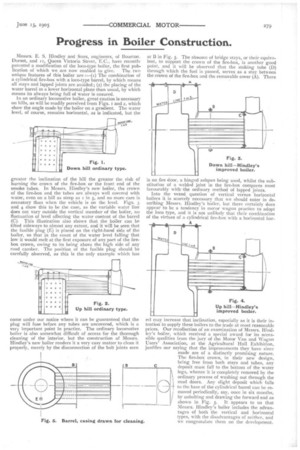Progress in Boiler Construction.
Page 9

If you've noticed an error in this article please click here to report it so we can fix it.
Messrs. E. S. Hindley and Sons, engineers, of Bourton. Dorset, and ii, Queen Victoria Street, EX., have recently patented a modification of the loco-type boiler, the first publication of which we are now enabled to give. The two unique features of this boiler are :—(1) The combination of a cylindrical fire-box with a loco-type barrel, by which means all stays and lapped joints are avoided ; (2) the placing of the water barrel in a lower horizontal plane than usual, by which means its always being full of water is ensured.
In an ordinary locomotive boiler, great caution is necessary on hills, as will be readily perceived from Figs. i and 2, which show the angle made by the boiler on a gradient. The water level, of course, remains horizontal, as is indicated, but the
greater the inclination of the hill the greater the risk of burning the crown of the fire-box or the front end of the smoke tubes. In Messrs. II indley's new boiler, the crown of the fire-box and the tubes are always well covered with water, even on a hill as steep as i in 5, and no more care is necessary than when the vehicle is on the level. Figs. 3 and 4 show this to be the case, as the variable water line does not vary outside the vertical member of the boiler, no fluctuation of level affecting the water content of the barrel (C). This illustration also shows that the boiler can be tilted sideways to almost any extent, and it will be seen that the fusible plug (E) is placed on the right-hand side of the boiler, so that in the event of the water level falling that low it would melt at the first exposure of any part of the firebox crown, owing to its being above the high side of any road camber. The position of the fusible plug should be carefully observed, as this is the only example which has
come under our notice where it can be guaranteed that the plug will fuse before any tubes are uncovered, which is a very important point in practice. The ordinary locomotive boiler is also somewhat difficult of access for the thorough cleaning of the interior, but the construction of Messrs. Hindley's new boiler renders it a very easy matter to clean it properly, merely by the disconnection of the bolt joints seen
at B in Fig. 5. The absence of bridge stays, or their equivalent, to support the crown of the fire-box, is another good point, and it will be observed that the stoking tube (D) through which the fuel is passed, serves as a stay between the crown of the fire-box and the removable cover (A). There is no fire door, a hinged ashpan being used, whilst the substitution of a welded joint in the fire-box compares most favourably with the ordinary method of lapped joints.
Into the vexed question of vertical versus horizontal boilers it is scarcely necessary that we should enter in describing Messrs. Hindley's boiler, but there certainly does appear to be a tendency in motor wagon practice to adopt the loco type, and it is not unlikely that their combination of the virtues of a cylindrical fire-box with a horizontal bar
re may increase that inclination, especially as it is their intention to supply these boilers to the trade at most reasonable peces. Our recollection of an examination of Messrs. Hindley's boiler, which received a special award for its accessible qualities from the jury of the Motor Van and Wagon Users' Association, at the Agricultural Hall Exhibition, justifies our saying that the improvements they have since made are of a distinctly promising nature. The fire-box crown, in their new design, being free from both stays and tubes, any deposit must fall to the bottom of the water legs, whence it is completely removed by the ordinary process of washing out through the mud doors. Any slight deposit which falls to the base of the cylindrical barrel can be removed periodically, say, once in six months, by unbolting and drawing the forward end as shown in Fig. 5. It appears to us that Messrs. Hindley's boiler includes the advantages of both the vertical and horizontal types, with the disadvantages of neither, and we congratulate them on the development.


















